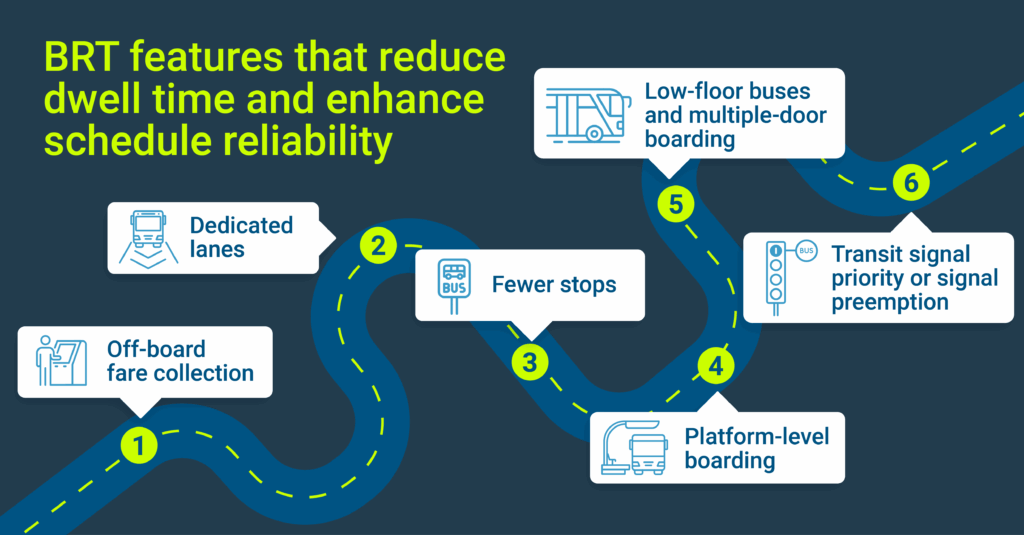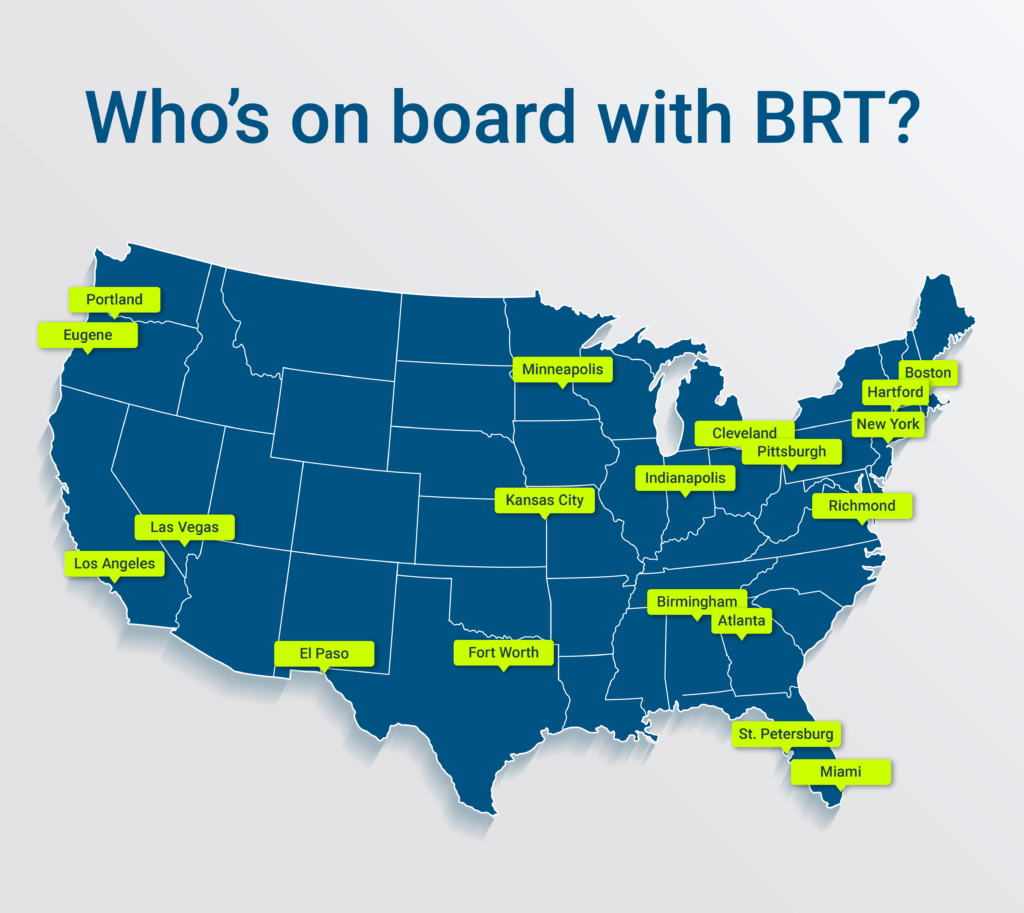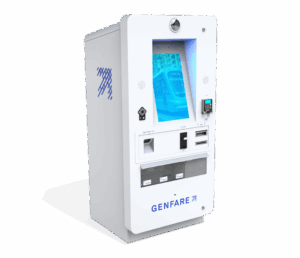In a rapidly changing urban mobility landscape, Bus Rapid Transit (BRT) is the fastest-growing transit mode, according to the Federal Transit Administration. In the U.S., 317 miles of BRT lines have been implemented since 2016, and miles traveled on BRT rose by 44 percent between 2013 and 2023, the largest increase among modes during that time.
BRT is a high-capacity, high-frequency system that typically includes dedicated bus lanes, transit signal priority, limited stops, and off-board and/or pre-paid fare collection. These and other time-saving features reduce delays, making BRT a step up from express bus service, which primarily relies on limited stops and sometimes freeway travel.

Growing interest in BRT
Back-to-office mandates mean that more people have returned to commuting to work. The conveniences of BRT can help motivate a concurrent return to public transit.
- For agencies, BRT can offer a cost-efficient alternative to light rail, providing a quick response to growing populations and urbanization, improving on-time performance, and providing opportunities for modernizing services.
- For communities, BRT can improve urban mobility, boost economic growth, enhance environmental quality, and better connect transit modes and regions.
- For riders, BRT is attractive because it provides faster, more efficient service, greater accessibility, and upgraded amenities such as real-time bus tracking, simplified, internet-connected ticketing, dedicated stations, and Wi-Fi.
 “The number one goal of BRT is reliability for the riders,” says Jennille Logan, Genfare Business Development Director for the Southeastern U.S. “Dedicated routes on the major thruways get families to appointments and get people to work so they can pay the bills. While there may be a significant up-front infrastructure investment, there is also value added — improved efficiency can attract more riders, potentially reducing operational costs.”
“The number one goal of BRT is reliability for the riders,” says Jennille Logan, Genfare Business Development Director for the Southeastern U.S. “Dedicated routes on the major thruways get families to appointments and get people to work so they can pay the bills. While there may be a significant up-front infrastructure investment, there is also value added — improved efficiency can attract more riders, potentially reducing operational costs.”
That said, every agency needs to look at what their ridership will support, and agencies know their ridership better than anyone else, she adds. “BRT decisions are really determined by the agency’s anticipated outcome, like increased rider access, increased ridership, and providing more timely service. But there are different ways to get there.”
Advantages of BRT
- Faster boarding through modernized onboard or off-board fare solutions
- Reduced travel times
- Improved schedule reliability/better on-time performance
- Enhanced equitable mobility
- Attracts new riders to a route
- Potential for collecting higher fares than traditional routes
- Extends transit reach and improves regional connectivity
- Distinct service line branding supports marketing outreach
Challenges of BRT
- While not nearly as costly as light rail, initial investment can be steep, including technology integration and operational expenses.
- Significant infrastructure changes may be needed, such as dedicated bus lanes, stations, and signal prioritization.
- Increased congestion may occur in areas with high traffic volume when general traffic lanes are converted to bus lanes.
- BRT infrastructure may conflict with existing underground utilities, requiring relocation or adjustments.
BRT standards
The Institute for Transportation and Development Policy (ITDP) sets an internationally recognized framework for evaluating and certifying BRT corridors that are at least six months old. Certification levels (including Basic, Bronze, Silver and Gold) are based on a scoring system that combines design evaluation (positive points) and operational evaluation (negative points).
Among the elements of BRT considered in the standard are Intelligent Transportation Systems (ITS). ITS focuses on the use of a wide range of technologies to improve transportation safety, efficiency, and convenience, including off-board and onboard fare collection technology. Genfare’s fare collection solutions can be integrated into a broader ITS framework as part of a BRT system.
Who’s on board with BRT?
 Transit agencies across the U.S. are increasingly recognizing the cost-efficient power of BRT to improve rider accessibility, encourage economic development, and provide fast, smooth connections throughout a region. Established BRT lines have been successful in larger cities like New York, Los Angeles, Boston, Pittsburgh, and Las Vegas, and in mid-sized and smaller cities like Cleveland, Minneapolis, Eugene, Indianapolis, Kansas City, Hartford, and Richmond.
Transit agencies across the U.S. are increasingly recognizing the cost-efficient power of BRT to improve rider accessibility, encourage economic development, and provide fast, smooth connections throughout a region. Established BRT lines have been successful in larger cities like New York, Los Angeles, Boston, Pittsburgh, and Las Vegas, and in mid-sized and smaller cities like Cleveland, Minneapolis, Eugene, Indianapolis, Kansas City, Hartford, and Richmond.
Among newer converts to BRT are Miami, Atlanta, and Fort Worth. New service or expanded routes have also been established recently in El Paso, Texas; Portland, Oregon; St. Petersburg, Florida; and Birmingham, Alabama.
Many agencies include rider-friendly features in their BRT stations such as:
- Faregates to collect fares pre-boarding and reduce fare evasion
- Park and ride lots and secure bike storage for multi-modal trips
- Real-time arrival signs
- Comfortable shelters with Wi-Fi, seating, lighting, heat, and air conditioning
Some BRT lines are smaller projects with dedicated purposes, such as the RTA Health Line BRT in Cleveland. The 7-mile line connects the city’s downtown central business district with University Circle, an activity and business center that includes University Hospitals, with stops along the Cleveland Clinic’s main campus on the way. This early U.S. BRT line saw route ridership increase by 80 percent in the five years after it opened.
Other BRT lines serve major corridors, like Miami-Dade Transit (MDT)’s new all-electric MetroExpress BRT, which began connecting hubs along the South Dade TransitWay corridor in July 2025.
Miami eyes 40 percent reduction in travel times
Miami-Dade’s MetroExpress stops at 14 air-conditioned stations on a dedicated 20-mile corridor, with pre-paid fares, level boarding, and amenities like air-conditioned vestibules, real-time bus arrival displays, and enhanced security including faregates. It is also served by park and ride lots and bike storage.
MetroExpress is part of a larger BRT commitment for Miami. MDT’s Strategic Miami Area Rapid Transit (SMART) program will eventually include five additional BRT corridors as part of a multi-billion-dollar expansion of the Miami-Dade transit system. It is expected to reduce peak time travel times by as much as 40 percent, according to the Miami-Dade County Department of Transportation and Public Works.
“MDT put a lot of care and thought into the design of their BRT system,” says Jennille. “They got the riders’ opinions and analyzed the data in order to support what riders have asked for.”
The placement of stops is data-informed, and capacity has been scrutinized to ensure there are enough vehicles available for reliable service. MDT also redesigned its street level corridor to allow BRT to have exclusive lane rights.
Fare collection that prioritizes rider convenience
To maximize BRT’s benefits, agencies must ensure a seamless and equitable fare collection process. A secure payment system allowing for a range of payment methods is critical. For unbanked or underbanked riders, accessibility is key. A reliable ticket point of sale at every station, operating as quickly and dependably as the BRT line itself, is essential to minimize dwell times and maintain schedule reliability.
Genfare’s Vendstar ticket vending machines (TVMs) address these needs head-on. In Miami-Dade Transit’s MetroExpress BRT, Vendstar TVMs at all 14 stations provide a cloud-connected, IoT-enabled solution that accepts multiple payment types, digitizes cash for unbanked riders, and ensures fast, secure transactions to keep buses moving on time. Real-time data also keeps its BRT running smoothly.
In addition to its preference for the most modern, future-proof, and rider-centric fare collection equipment to support its Bus Rapid Transit vision, MDT wanted to increase safety and step up its fare evasion prevention efforts with faregates at its new BRT stations. The faregates built specifically for Miami and soon to be available to all Genfare customers, help protect MDT’s investment.
“The prevailing focus of BRT is getting riders to where they need to be in the easiest and most seamless way possible,” Jennille adds. Whether a BRT system chooses to accept onboard or off-board payments – or a combination – the key is all-in-one, customizable fareboxes and/or TVMs that can quickly accept, validate, and process payment.
This not only helps riders board quickly at multiple doors so that buses stay on time, but optimized fare collection also helps agencies ensure that everyone using a BRT corridor can pay with whatever is in their pocket or purse. Providing opportunities for all members of a community, including the underbanked or unbanked, people with disabilities, students, or seniors, to ride with ease, is a form of equitable mobility that benefits everyone involved, Jennille says.
“At Genfare, for example, our equipment is designed to be equitable not only for the riders, but for the agency, their staff, their drivers, and taxpayers,” she says.
Introducing Vendstar 5
 Reduce dwell time by having riders digitize cash, purchase tickets, or reload fare media before they board at Genfare’s all-new, reliable self-service kiosk. Highlights include:
Reduce dwell time by having riders digitize cash, purchase tickets, or reload fare media before they board at Genfare’s all-new, reliable self-service kiosk. Highlights include:
- Easy to use: Accepts all methods of payment, includes a large touchscreen LCD, is ADA compliant, and can include multiple languages
- Configurable: Works with Genfare Link or third-party back office software, dispenses a variety of fare media, and accepts cash and cashless payments. Even the case color, onscreen messaging, and climate control options are configurable.
- True IoT device: Includes remote monitoring, predictive maintenance, real-time data transfer, and over-the air configuration.
Keeping BRT running smoothly
Agencies can better monitor their BRT investment, optimize service, advance equity, and plan ahead when they have easy access to data. Connected, smart hardware can generate a unified stream of real-time data insights about how people are paying fares, whether it’s with cash, card, smart card, or mobile. This helps to better determine the number of TVMs or staff needed during peak times, for example, and can catch fare and equipment problems early, says Jennille.
When considering whether BRT is right for their system and community, agencies should get up to speed on principles and attributes of BRT, technology integration, planning and analysis needs, and funding and financing requirements, while engaging riders in the process.
“Often, agencies will hire an engineering firm to help with the BRT. That’s okay, but I would say agencies need to educate themselves as well, so that they’re not a passenger in the future of their system,” Jennille says “Choose partners who are going to be in this together with you and who support your vision. And don’t be afraid to stand up for what’s best for your riders.”